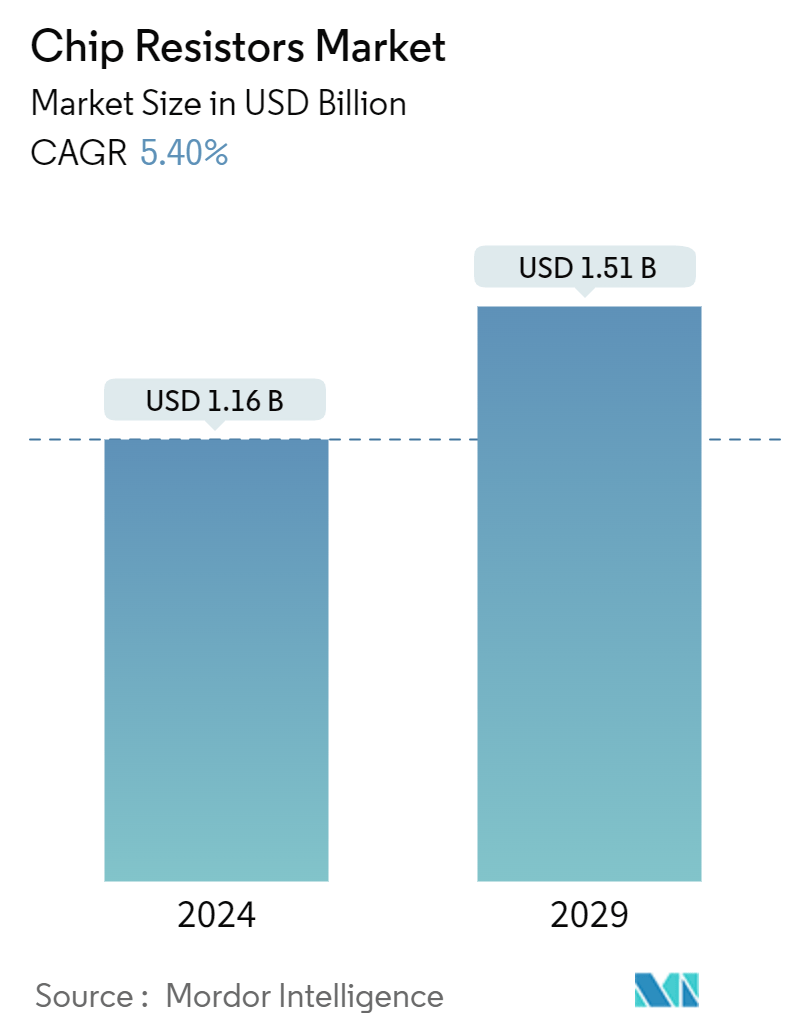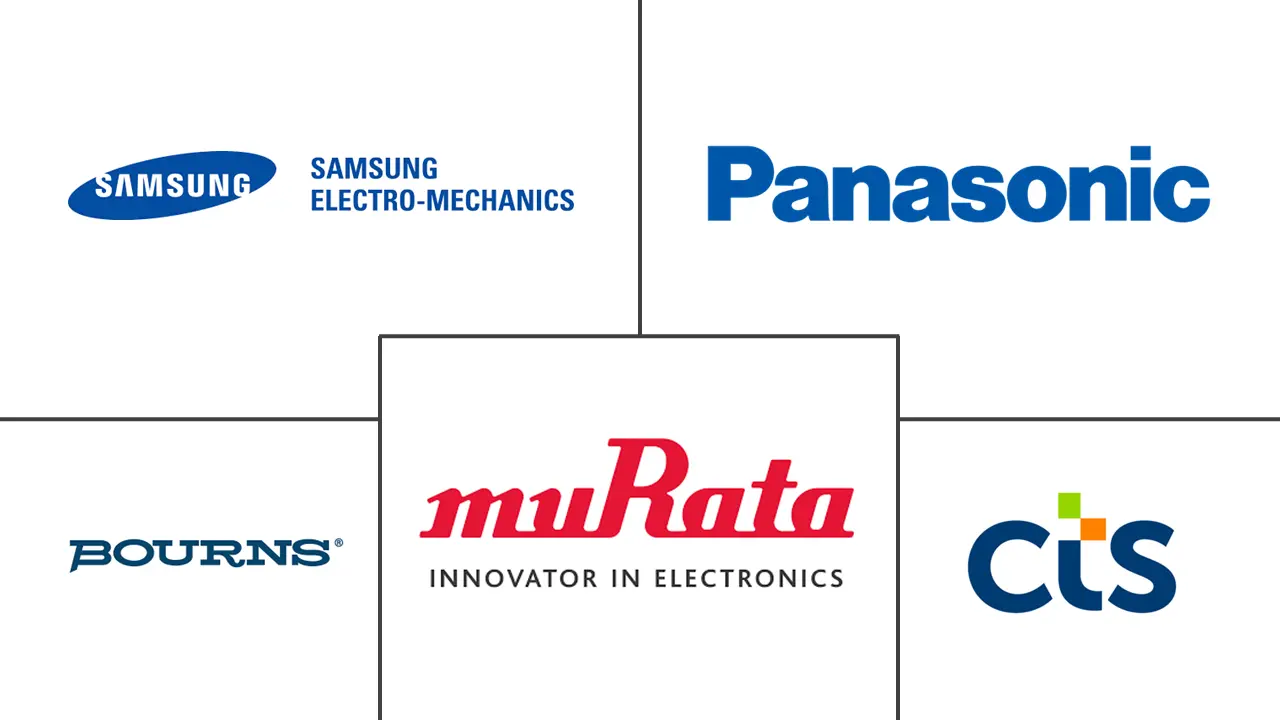Market Size of Chip Resistors Industry

| Study Period | 2019 - 2029 |
| Market Size (2024) | USD 1.16 Billion |
| Market Size (2029) | USD 1.51 Billion |
| CAGR (2024 - 2029) | 5.40 % |
| Fastest Growing Market | Asia Pacific |
| Largest Market | Asia Pacific |
| Market Concentration | Medium |
Major Players
*Disclaimer: Major Players sorted in no particular order |
Chip Resistors Market Analysis
The Chip Resistors Market size is estimated at USD 1.16 billion in 2024, and is expected to reach USD 1.51 billion by 2029, growing at a CAGR of 5.40% during the forecast period (2024-2029).
The large-scale digitization across various sectors and the proliferation of applications like the Internet of Things, AI, and cloud computing are anticipated to offer a significant boost to the growth of the studied market.
- Several chip resistor types are available to address the design and application requirements, such as general-purpose chip resistors, high precision chip resistors, current sense chip resistors, high voltage chip resistors, high power chip resistors, and high resistance chip resistors.
- General-purpose chip resistors are utilized in surface-mount circuit designs wherever a standard or general resistor for voltage reduction (voltage dividers), current control (current limiters), or similar requirements is needed. These are typically thick-film resistors. In the present market scenario, thick film resistors gain significant traction due to their increasing application in test and measurement equipment, monitoring equipment, medical equipment, audio, precision controls, and instrumentation.
- High-voltage circuits are standard for lighting, HV instrumentation, HV industrial, or other HV applications where high-voltage chip resistors are needed. High-power resistors may be used in general-purpose resistors where high power density is required, as they offer higher power ratings than general-purpose chip resistor analogs. High-resistance chip resistors are typically used in high-impedance instruments, test equipment circuits, temperature measurement circuits, voltage dividers, circuits for gain setting, etc.
- Electric car sales are expanding at a rapid pace each year, assisting the automobile industry in combating climate change and other environmental issues. According to the International Energy Agency, sales of EVs significantly increased in 2022, accounting for 1.02 million electric vehicles. Such instances indicate the growing demand for MLCC in the automotive sector. Further, the high adoption of EVs and the complete phase-out dates of ICE engines set by various governments will drive the growth of MLCC in the automotive sector. Manufacturers of electric cars install chip resistors to increase the energy efficiency and robustness of the electronic systems used in these vehicles. These advancements in the automobile industry will fuel market trends.
- On the flip side, unprecedented increases in the cost of ruthenium, a critical element in the production of thick film paste incorporated in thick film chip resistors, have resulted in delayed lead times. Moreover, due to the large percentage of variable costs in the production of chip resistors relying on raw materials, price surges and short supply are anticipated for the rest of FY 2022.
- In addition, the trade disputes in South Africa regarding platinum mines are directly impacting the fluctuations in these prices. Ruthenium has experienced a significant price increase in the last few years, from USD 40 per troy ounce to as high as USD 850 per troy ounce, corresponding with shortages of thick film chip resistors. However, this price increase has resulted in customers seeking alternative resistor designs, including those based on thin-film nickel.
Chip Resistors Industry Segmentation
A chip resistor is a passive electronic component that limits the flow of direct current (DC) and alternating current (AC).
The chip resistors market is segmented by type (thick chip resistor, thin chip resistor, general purpose chip resistor), application (industrial, consumer electronics, automotive & transportation, telecommunication, aerospace and defense), and geography (North America, Europe, Asia Pacific, Latin America, the Middle East, and Africa). The market sizes and forecasts are provided in terms of value (USD) for all the above segments.
| By Type | |
| Thick Chip Resistor | |
| Thin Chip Resistor |
| By Application | |
| Industrial | |
| Consumer Electronics | |
| Automotive and Transportation | |
| Telecommunication | |
| Aerospace and Defence | |
| Others |
| By Geography | |
| North America | |
| Europe | |
| Asia | |
| Australia and New Zealand | |
| Latin America | |
| Middle East and Africa |
Chip Resistors Market Size Summary
The chip resistors market is poised for significant growth, driven by the increasing digitization across various sectors and the expanding applications of technologies such as the Internet of Things, artificial intelligence, and cloud computing. This market encompasses a variety of chip resistor types, including general-purpose, high precision, current sense, high voltage, high power, and high resistance chip resistors, each catering to specific design and application needs. The demand for thick-film resistors is particularly strong due to their widespread use in test and measurement equipment, medical devices, and precision controls. The automotive sector, especially with the rise of electric vehicles, is a key driver of market expansion, as chip resistors are integral to enhancing the energy efficiency and robustness of electronic systems in vehicles. However, challenges such as the rising cost of raw materials like ruthenium, essential for thick-film chip resistors, and trade disputes affecting supply chains, pose potential hurdles to market growth.
The market is moderately consolidated, with major players like CTS Corporation, Murata Manufacturing Co. Ltd., and Panasonic Corporation leading the charge through strategic acquisitions and partnerships to bolster their market presence. Innovations in resistor technology, such as Bourns Inc.'s expansion of its metal foil current sense resistor series and TT Electronics' introduction of high-power thin-film chip resistors, highlight the industry's focus on enhancing precision, reliability, and power handling capabilities. The defense industry also presents a significant opportunity for growth, as chip resistors are crucial in high-precision applications like radar and missile guidance systems. Despite challenges in raw material costs and supply chain disruptions, the market is expected to continue its upward trajectory, supported by ongoing advancements in resistor technology and increasing demand from various sectors.
Chip Resistors Market Size - Table of Contents
-
1. MARKET INSIGHTS
-
1.1 Market Overview
-
1.2 Industry Attractiveness - Porter's Five Forces Analysis
-
1.2.1 Bargaining Power of Suppliers
-
1.2.2 Bargaining Power of Buyers
-
1.2.3 Threat of New Entrants
-
1.2.4 Threat of Substitutes
-
1.2.5 Intensity of Competitive Rivalry
-
-
1.3 Value Chain Analysis
-
1.4 Assessment of Impact of COVID-19 on the Market
-
-
2. MARKET SEGMENTATION
-
2.1 By Type
-
2.1.1 Thick Chip Resistor
-
2.1.2 Thin Chip Resistor
-
-
2.2 By Application
-
2.2.1 Industrial
-
2.2.2 Consumer Electronics
-
2.2.3 Automotive and Transportation
-
2.2.4 Telecommunication
-
2.2.5 Aerospace and Defence
-
2.2.6 Others
-
-
2.3 By Geography
-
2.3.1 North America
-
2.3.2 Europe
-
2.3.3 Asia
-
2.3.4 Australia and New Zealand
-
2.3.5 Latin America
-
2.3.6 Middle East and Africa
-
-
Chip Resistors Market Size FAQs
How big is the Chip Resistors Market?
The Chip Resistors Market size is expected to reach USD 1.16 billion in 2024 and grow at a CAGR of 5.40% to reach USD 1.51 billion by 2029.
What is the current Chip Resistors Market size?
In 2024, the Chip Resistors Market size is expected to reach USD 1.16 billion.

